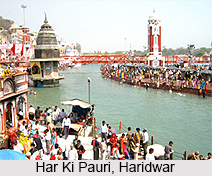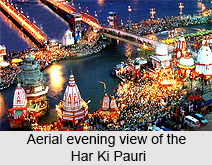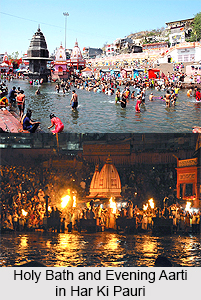 Har Ki Pauri or "Jai Ganga Maa Har Ki Pauri" is the premier religious spot in the sacred city of Haridwar, in the Indian state of Uttarakhand. It is a famous "ghat", a series of footsteps leading down to the waters of a holy river, here the highly revered River Ganga. It is said to be the very spot where the Ganges gets separated from the mountains and enters the plains. The ghat is on the western banks of the Ganges canal, through which the river gets diverted only to the north.
Har Ki Pauri or "Jai Ganga Maa Har Ki Pauri" is the premier religious spot in the sacred city of Haridwar, in the Indian state of Uttarakhand. It is a famous "ghat", a series of footsteps leading down to the waters of a holy river, here the highly revered River Ganga. It is said to be the very spot where the Ganges gets separated from the mountains and enters the plains. The ghat is on the western banks of the Ganges canal, through which the river gets diverted only to the north.
Etymology of Har Ki Pauri, Uttarakhand
The Har Ki Pauri derives its name from the Sanskrit word for Lord Shiva "Hara" and for footsteps "Pauri", literally signifying the footsteps of the Lord. Legend has it that Lord Shiva and Lord Vishnu had visited the Brahma Kund in Har Ki Pauri in the Vedic era. A large footprint on a stone wall here is said to belong to Lord Vishnu.
 History of Har Ki Pauri, Uttarakhand
History of Har Ki Pauri, Uttarakhand
King Vikramaditya is believed to have founded Har Ki Pauri in the 1st century BC, to commemorate his brother Bhatrihari, who had come to meditate here on the bank of the Ganges River. Over the years, the ghats in Har Ki Pauri have undergone major extensions and renovations for the crowds which have multiplied manifold in the Kumbha Mela. Several temples have come up on the steps, most built in the late 19th century. The extension of the ghats were first carried out in 1938 by Hargyan Singh Katara, a zamindar from Agra in Uttar Pradesh, and then again in 1986.
Religious Significance of Har Ki Pauri, Uttarakhand
Har Ki Pauri is the place where millions of Hindu devotees and pilgrims converge during the festivals of Kumbha Mela, the largest religious fair in the world held once in every 12 years, the Ardh Kumbha Mela, held once in every 6 years and the Punjabi festival of Baisakhi every year in the month of April.
 Har Ki Pauri is considered sacred also because of the legend in Samudra Manthan which says that drops of "Amrit", the elixir of immortality, fell from the pitcher while being carried by the celestial bird Garuda, onto the Brahma Kund. For this legend, the Brahma Kund is considered the most sacred ghat in Har Ki Pauri.
Har Ki Pauri is considered sacred also because of the legend in Samudra Manthan which says that drops of "Amrit", the elixir of immortality, fell from the pitcher while being carried by the celestial bird Garuda, onto the Brahma Kund. For this legend, the Brahma Kund is considered the most sacred ghat in Har Ki Pauri.
Every day, the Har Ki Pauri ghats witness hundreds of devotees taking a dip in the holy waters of the Ganges, to wash away all sins and in attainment of "moksha", freedom from the cycle of birth and death. The daily evening Ganga Aarti in the Brahma Kund is an enchanting experience for every Hindu devotee, when priests perform worship to the holy Ganga, holding large flame lit bowls and chanting prayers along, with a large number of people enthusiastically gathering together and singing the praises. The temple gongs start resonating in the ghats and the sound of chants sung aloud fill up the atmosphere. People float earthen "diyas", flame lit lamps with religious flowers on the holy waters as a symbol of hope and wishes. The golden hues of the floral and flickering "diyas" drifting downstream get reflected in the waters, lending a striking and spectacular visual.
Every year, generally on the night of Dussehra, the waters of the Ganga canal in Haridwar are partially dried, for the purpose of cleaning the riverbed and undertake the repairing of the ghats. The Ganga Aarti is held every day as usual. The waters are generally restored on the night of Diwali. It is believed that Maa Ganga visits her paternal home on Dussehra and returns on the festival of Bhai Dooj or Bhai Phota, which is two days after the festival of Diwali.











